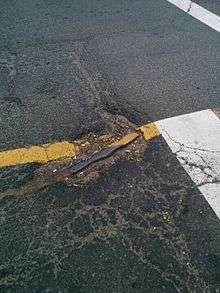Sudbury and Copper Cliff Suburban Electric Railway
The Sudbury & Copper Cliff Suburban Electric Railway is a historic Canadian railway that operated in Sudbury, Ontario.
History
The railway began operations in 1912 with a single car that was borrowed from the Toronto Suburban Railway. The car was never returned and operated on the SCCSER until the early 1930s when it was sold for scrap. Service was only provided to Copper Cliff initially, with the lines on Notre Dame and Elgin opening shortly afterwards. In 1943, the workers at the railway unionized,[1] but by then its time was nearly over as the SCCSER began buying buses in 1947. The line to Bell Park was the first to close in 1948 with the two other lines ceasing service in 1950. The SCCSER rolling stock sat at the carhouse for more than two years, finally being cut up for scrap in 1953. The SCCSER was reorganized in 1951 and renamed Sudbury Bus Lines Limited. None of the original equipment or infrastructure was ever preserved.
Routes
The SCCSER had three main routes radiating from Elm Street in downtown Sudbury. The westerly (and busiest) route ran a short distance from the Elm/Durham intersection to Lorne Street, where it turned south and entered dedicated trackage along the east side of the road. After about 100 metres, the streetcar line and the road angled southwest, running parallel to the Canadian Pacific's Webbwood subdivision. At Gatchell the streetcar line split into two tracks opposite Tuddenham Street to facilitate the passing of cars in rush hour. The line, once again single-track, then continued southwest, passing underneath the INCO railway via a specially-constructed underpass to a junction near Balsam Street in Copper Cliff, where it met the shuttle to the INCO refinery a short distance away. The line then angled northwest and ended at the two-track station near downtown Copper Cliff. It operated right up until the end of rail service in 1950. In addition to this service there was also a short-turn service that ended at Gatchell during peak hours. The northerly route ran from a wye at the Elm/Durham intersection to the SCCSER carhouse at St. Charles Street. This line was entirely single-track and operated for a short distance in the middle of Notre Dame Avenue before entering its own right-of-way on the east side of the road parallel to the CP Stobie Spur. This line operated right up until the end of service in 1950, but had been replaced by buses during peak periods in its last months of operation to clear the line for cars deadheading to and from the carhouse. The easterly line ran east in the middle of Elm street for approximately 75 metres before turning south on Lisgar, west on Cedar and south again on Durham. This odd arrangement was rumoured to have existed in order to ensure the carline's passage by a liquor store owned by a controlling interest in the SCCSER, but was more likely done to avoid crossing the CP Stobie Spur twice. Coming to the end of the trackage on Durham, the line entered a private right-of-way on the south side of Elgin Street and angled southeast parallel to the CP mainline through downtown. Passing the CP station at Van Horne, the line turned south across the Nelson Street "Iron" bridge (which was repurposed into a pedestrian bridge and is still used as such today[2] ) and continued in the middle of Nelson Street to John Street, turning east and running one block to Elizabeth Street, where it turned south once again and ran down the middle of Elizabeth to Bell Park on the shore of Ramsey Lake. This line was also entirely single-track and ceased service in 1948 after the tracks on Lisgar Street were accidentally paved over by a contractor doing road repairs there.
The SCCSER today

Today the SCCSER has all but vanished. None of the streetcar equipment was ever retained for preservation. The streetcar alignments on Lorne and Notre Dame have since been obliterated by road-widening projects and all track was removed from city streets. Traces of the right-of-way near Copper Cliff, including the INCO railway underpass are purported to exist, however they could not be found on any satellite photographs of the area.
External links
References
- ↑ "A Brief History of Unions in Sudbury". RepublicOfMining.com. 27 May 2010. Retrieved 9 May 2016.
- ↑ Keowne, Mary Katharine (26 September 2013). "Inco retiree reflects on past days of riding the 'rails' in Sudbury". The Sudbury Star. Retrieved 18 January 2014.